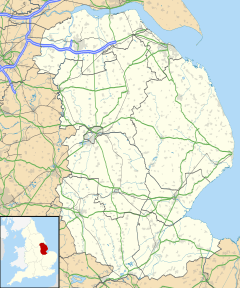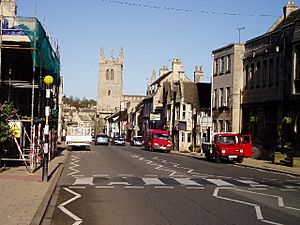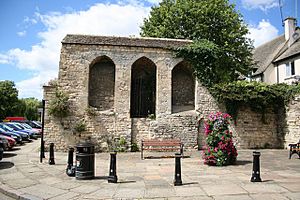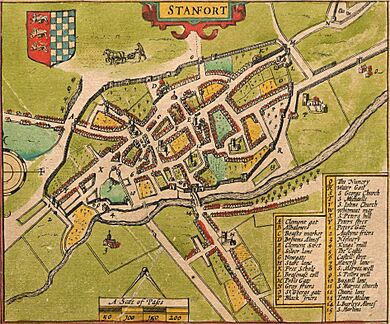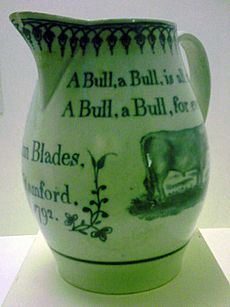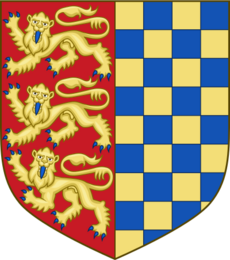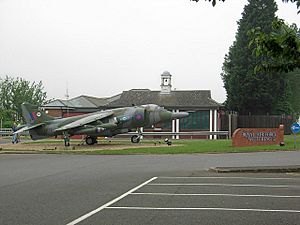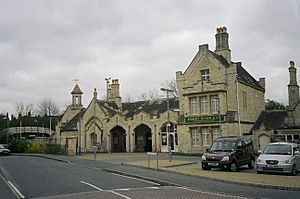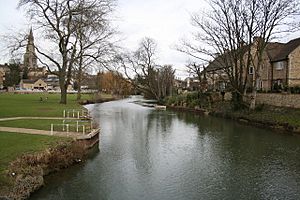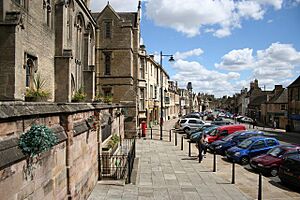Stamford, Lincolnshire facts for kids
Quick facts for kids Stamford |
|
|---|---|
 St Mary's Hill, Stamford |
|
| Population | 20,742 (2021 Census) |
| OS grid reference | TF0207 |
| • London | 92 mi (148 km) S |
| Civil parish |
|
| District |
|
| Shire county | |
| Region | |
| Country | England |
| Sovereign state | United Kingdom |
| Post town | STAMFORD |
| Postcode district | PE9 |
| Dialling code | 01780 |
| Police | Lincolnshire |
| Fire | Lincolnshire |
| Ambulance | East Midlands |
| EU Parliament | East Midlands |
| UK Parliament |
|
Stamford is a historic town and civil parish located in Lincolnshire, England. It is known for its beautiful 17th and 18th-century stone buildings. You can also find older timber-framed houses and five medieval churches here. Stamford is often chosen as a place to film movies and TV shows. In 2013, The Sunday Times newspaper even called it a top place to live. The town's name was later given to Stamford, Connecticut, in the USA, which was founded in 1641.
Contents
- Discover Stamford's Past: A Journey Through History
- How Stamford is Governed
- Stamford's Location and Natural Features
- Stamford's Economy: How People Make a Living
- Famous Places and Buildings in Stamford
- Getting Around Stamford: Transport
- Education in Stamford
- Churches in Stamford
- Stamford as a Filming Location
- Famous People from Stamford
- Sports in Stamford
- Festivals and Events in Stamford
- Images for kids
- See also
Discover Stamford's Past: A Journey Through History
Ancient Roots: Roman and Medieval Stamford
Long ago, the Romans built a major road called Ermine Street right through what is now Burghley Park. They crossed the River Welland near Stamford. Later, the Anglo-Saxons chose Stamford as an important town. It was located on a larger river than the nearby River Gwash.
The name Stamford first appeared in old records as Steanford in 922. It means "stony ford," which is a shallow place in a river where you can cross by foot.
In 972, King Edgar made Stamford a "borough." This meant it was a town with special rights. Stamford was a Danish settlement, located where the River Welland could be crossed. It was famous for making pottery called Stamford Ware. Later, it became known for its woollen cloth, called Stamford cloth or haberget. This cloth was even sold in Venice during the Middle Ages.
Stamford used to be a walled town, but only a small part of the wall remains today. It became an important inland port on the Great North Road. This road became more important than Ermine Street. Important old buildings still standing include Browne's Hospital and Stamford School, which started in 1532.
A Norman castle was built around 1075. It was taken down in 1484. Today, a bus station and houses are on the old castle site. Only a small piece of the castle wall is left.
In the 1330s, some students from Oxford University tried to start a new college in Stamford. The kings of Oxford and Cambridge asked Edward III to stop them. The king ordered the new college to close. For many years, Oxford students had to promise not to study in Stamford.
Stamford has held an annual fair since the Middle Ages. It is still one of the largest street fairs in Lincolnshire. In 1190, a sad event happened at the fair. People preparing for a crusade attacked and killed some Jewish residents. The others found safety in the castle.
Religious Buildings and Hospitals in Stamford
Because Stamford was so important and wealthy in the Middle Ages, many religious houses and hospitals were built. These included monasteries and friaries. Most of them closed down by 1539. You can still see their influence in street names like Priory Street.
- Monasteries
* Priory of St Leonard: Started by 1082, part of its church still stands. * Priory of Austin Canons at Newstead: Started as a hospital, then became a priory in the 1240s. * Priory of St Michael: A large nunnery for about 40 nuns.
- Friaries
* Austin Friars: Established in the 1340s. * Dominican Friars: Likely arrived in the 1230s. * Franciscan Friars: Had a house called Greyfriars, Stamford. * Carmelite Friars: Founded around 1268, known for its beautiful church. * Friars of the Sack: Named for their simple sackcloth clothes.
- Hospitals
* Hospital of St John Baptist and St Thomas the Martyr: Existed from 1323. * Hospital of St Giles: Built outside Stamford for people with leprosy. * Hospital of All Saints: Founded in 1485 by William Browne, a wool merchant. It still helps poor people today.
Stamford in Tudor and Stuart Times
By the early 1500s, the wool industry in England declined, which affected Stamford. The town became poorer, and its population dropped to about 800 people. Many churches were combined.
However, by the late 1600s, Stamford began to grow again. Leather, fabric work, and wood and stone crafts were important jobs.
The River Welland was made navigable again in the 1660s. This meant boats could travel on it. Stamford then became a center for making malt, which is used in brewing. Barley from nearby farms could easily reach the town by river.
The Great North Road passed through Stamford. It was a popular stopping place for travelers. Important people like Henry VIII and Queen Elizabeth I visited the town. In 1663, new laws helped improve the roads. This made Stamford even more important for travel in the next century.
During the English Civil War, people in Stamford had different loyalties. Some supported Parliament, and others supported the King. In 1643, Royalist forces at Burghley were defeated and surrendered.
The Stamford Bull Run
For over 600 years, Stamford held a special event called the Stamford bull run. It happened every year on November 13th until 1839. A local story says it started when a lord saw two bulls fighting. He enjoyed it so much that he gave land to the butchers of Stamford. In return, they had to provide a bull for the run every year.
Modern Stamford: Victorian Era to Today
The main railway line, the East Coast Main Line, was planned to go through Stamford. However, due to local resistance, it was built through Peterborough instead. This helped Peterborough grow more than Stamford.
During World War II, Stamford had several military sites. This included an RAF station and a prisoner-of-war camp. A 2,000-pound bomb was dropped on St Leonard Street in 1940 but did not explode. About 1,000 people had to leave their homes until it was made safe.
Stamford Museum used to be in a Victorian building. It closed in 2011 due to budget cuts. Some of its exhibits are now at the town library and Stamford Town Hall.
How Stamford is Governed
Stamford has three levels of local government:
- Stamford Town Council: This is the local council for the town. It meets at Stamford Town Hall, built in 1779.
- South Kesteven District Council: This council handles services for a larger area.
- Lincolnshire County Council: This council manages services for the whole county.
Stamford's Administrative History
Stamford was an old "borough." Originally, it was only on the north side of the River Welland. The south side, called Stamford Baron, was in a different county. In 1836, the town's boundaries were changed to include Stamford Baron.
After this, Stamford was in two different counties. But in 1889, towns were not allowed to be in two counties. So, the parts south of the river became part of Lincolnshire. In 1974, the borough of Stamford was replaced by the new South Kesteven District Council. Stamford Town Council was then created to cover the old borough area.
The town council has a special symbol, called "arms." It shows three gold lions, which are the English royal arms. These were given to the town by King Edward IV. It also shows blue and gold squares, which are the symbols of the De Warenne family, who owned land here in the 1200s.
Who Represents Stamford in Parliament?
Stamford is part of the Rutland and Stamford area for Parliament. The current Member of Parliament (MP) is Alicia Kearns from the Conservative Party. An MP is a person elected to represent their local area in the UK Parliament.
Stamford's Location and Natural Features
Stamford is located on the River Welland. It is in the southwest part of Lincolnshire. Nearby counties include Rutland and Northamptonshire.
The River Welland forms the border between Lincolnshire and the historic Soke of Peterborough (in Northamptonshire).
In 1991, the border between Lincolnshire and Rutland was changed. It now mostly follows the A1 main road.
Stamford's Geology: Rocks and Stones
Most of Stamford is built on a type of rock called Lincolnshire limestone. This area is famous for its limestone and slate quarries. Many buildings in Stamford have cream-coloured Collyweston stone slate on their roofs.
Ancient Life: Palaeontology in the Area
In 1968, a very old dinosaur skeleton was found near Stamford. It was a Cetiosaurus oxoniensis, about 15 meters (50 feet) long. This dinosaur lived about 170 million years ago! It is one of the most complete dinosaur skeletons found in the UK. You can see it at the Leicester Museum & Art Gallery.
Stamford's Economy: How People Make a Living
Tourism is very important to Stamford's economy. Many people visit the town. Law and accounting firms also play a big role. Health, education, and other public services are major employers. This includes Stamford and Rutland Hospital and local schools.
The town has many hotels, restaurants, and cafes. You can find places like the George Hotel and the Lord Burghley. These names reflect the town's long history. Nearby Rutland Water and events at Burghley House also create jobs.
Shopping in Stamford
Stamford's town center has many unique, independent shops. People come from all around to shop here. Some streets are even closed to traffic, making them nice for walking. You can find gift shops, clothing stores, florists, and beauty salons.
There are also larger stores and supermarkets. Stamford has car showrooms and businesses related to cars. Local services include convenience stores and post offices.
Engineering and Industry
South of Stamford is RAF Wittering, an important air force base. It was once home to the Harrier aircraft. The base opened in 1916.
Cummins Generator Technologies (formerly Newage Lyon) is an engineering company in Stamford. It makes electrical generators. Other smaller businesses like welders and printers are also in the town.
Stamford is surrounded by rich farmland. Agriculture still provides jobs in farming and related services.
Media and Publishing
The Stamford Mercury newspaper claims to be "Britain's oldest continuously published newspaper." It has been published since 1712.
Local radio stations include Greatest Hits Radio Midlands. You can also listen to BBC Radio Cambridgeshire and BBC Radio Lincolnshire.
Publishers in Stamford include Key Publishing (aviation magazines) and the Bourne Publishing Group (pet magazines).
Famous Places and Buildings in Stamford
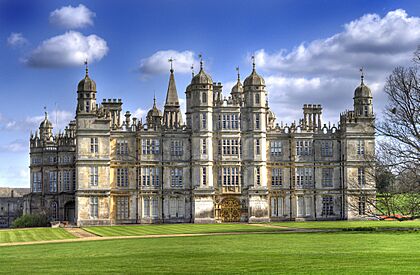
Stamford was the first "conservation area" in England and Wales. This means its historic buildings are protected. There are over 600 listed buildings in the town. The Corn Exchange, built in 1859, is another important building.
The Industrial Revolution did not change Stamford much. Most of the town center was built in the 17th and 18th centuries. It has many stone buildings made from local limestone. You can see old coaching inns with large doorways. The main shopping area was made pedestrian-friendly in the 1970s.
Near Stamford is Burghley House, a grand Elizabethan mansion. It was built by Sir William Cecil, an important advisor to Queen Elizabeth I. It is still the home of the Marquess of Exeter family. Another country house nearby, Tolethorpe Hall, hosts outdoor theater shows.
Tobie Norris had a bell foundry in Stamford in the 1600s. A pub in St Paul's Street is named after him.
Getting Around Stamford: Transport
Stamford's Railway Station
The town has Stamford railway station. It used to be called Stamford Town to tell it apart from another station that is now closed. The station building is made of stone in a Mock Tudor style.
Trains run to places like Leicester, Birmingham New Street, and Stansted Airport. You can also catch trains to Peterborough and Norwich.
Roads Around Stamford
Stamford is on the main north-south road, the A1. This road goes from London to York and Edinburgh. In the Middle Ages, Stamford hosted several Parliaments because of its location. Old coaching inns like the George Hotel were well-known.
The town's narrow streets used to get very busy with traffic. In 1960, a bypass was built to the west of the town. This helped reduce traffic in the center.
Walking Paths in Stamford
You can cross the River Welland on footbridges at the Meadows and Albert Bridge.
Several long-distance walking paths go through Stamford:
- The Jurassic Way runs from Banbury to Stamford.
- The Hereward Way goes through the town, following the Roman Ermine Street.
- The Macmillan Way also passes through Stamford.
Bus Services
The town's bus station is on St Peter's Hill.
Local bus services connect Stamford to places like Peterborough, Oakham, Grantham, and Bourne. There is also a National Express coach service to London and Nottingham.
Waterways: The River Welland
In the past, boats used a canal to carry goods from Market Deeping to warehouses in Stamford. This is no longer possible because the canal is not used, and the river is too shallow.
Education in Stamford
Stamford has several primary schools: Bluecoat, St Augustine's, St George's, St Gilbert's, and Malcolm Sargent. There is also an independent school, Stamford Junior School.
The main state secondary school is Stamford Welland Academy. It became an "academy" in 2011. An academy is a school that gets money directly from the government and is not controlled by the local council.
Stamford School (for boys) and Stamford High School (for girls) are well-known independent schools. They have about 1,500 students. Stamford School started in 1532, and the High School in 1877. Since 2000, older students (in the sixth form) have classes together. These schools are part of the Stamford Endowed Schools.
New College Stamford offers education for students aged 16 and older. It has vocational courses, academic courses, and even some university-level courses.
Churches in Stamford
In the 2011 Census, most people in Stamford identified as Christian. However, over 25 percent said they had "no religion." Stamford has many churches, some still active and some now used for other purposes:
- All Saints' Church
- Christ Church
- Stamford Free Church (Baptist)
- St George's Church
- St John the Baptist
- St Leonard's Priory
- St Mary's Church
- St Mary and St Augustine (Roman Catholic)
- St Martin's Church
- St Michael the Greater (now shops)
- St Paul's Church (now Stamford School's chapel)
- Stamford Methodist Church
- United Reformed Church
Stamford as a Filming Location
Stamford's beautiful old buildings make it a popular place for filming.
Television Shows Filmed in Stamford
- Middlemarch (1994)
- The Buccaneers (1995)
- Bleak House (2005)
- My Mad Fat Diary (2013–2015)
Movies Filmed in Stamford
- Pride & Prejudice (2005) – Stamford was used as the village of Meryton.
- The Da Vinci Code (2006)
- The Golden Bowl (2000)
Famous People from Stamford
Many interesting people have lived in or are connected to Stamford.
Arts and Entertainment
- Michael Asher (born 1953): An author and explorer.
- Colin Dexter (1930–2017): The author who created the famous Inspector Morse character.
- Rae Earl (born 1971): An author and broadcaster.
- James Mayhew (born 1964): A writer and illustrator of children's books.
- Sarah Cawood (born 1972): A television presenter.
- James Bradshaw (born 1976): A stage and television actor.
- Tom Davis: An actor and comedian.
- Colin Furze (born 1979): A popular YouTube personality.
- Nicola Roberts (born 1985): A singer from the group Girls Aloud.
- George Robinson (born 1997): An actor.
- Sir Malcolm Sargent (1895–1967): A famous conductor.
- Sir Michael Tippett (1905–1998): A well-known composer.
Sports Stars
- David Cecil, 6th Marquess of Exeter (1905–1981): An Olympic Gold Medal-winning hurdler.
- Malcolm Christie (born 1979): A former professional footballer.
- Darren Ferguson (born 1972): A football manager.
- M. J. K. Smith (born 1933): A former captain of the England cricket team.
Sports in Stamford
Football Teams
- Blackstones F.C.
- Stamford A.F.C.
- Stamford Belvedere F.C.
There are also many junior and school football teams.
Rugby Teams
- Stamford College Old Boys R.F.C.
- Stamford College Rugby Team
- Stamford Rugby Club
Cricket Teams
- Burghley Park Cricket Club
- Stamford Town Cricket Club
Festivals and Events in Stamford
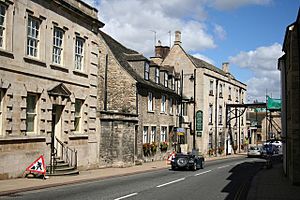
Stamford hosts several exciting events throughout the year:
- Burghley Horse Trials: A famous equestrian event held every September.
- Stamford Blues Festival: A music festival.
- Stamford Mid Lent Fair: A large street fair.
- Stamford Georgian Festival: A festival celebrating the Georgian era.
Images for kids
See also
 In Spanish: Stamford (Lincolnshire) para niños
In Spanish: Stamford (Lincolnshire) para niños


